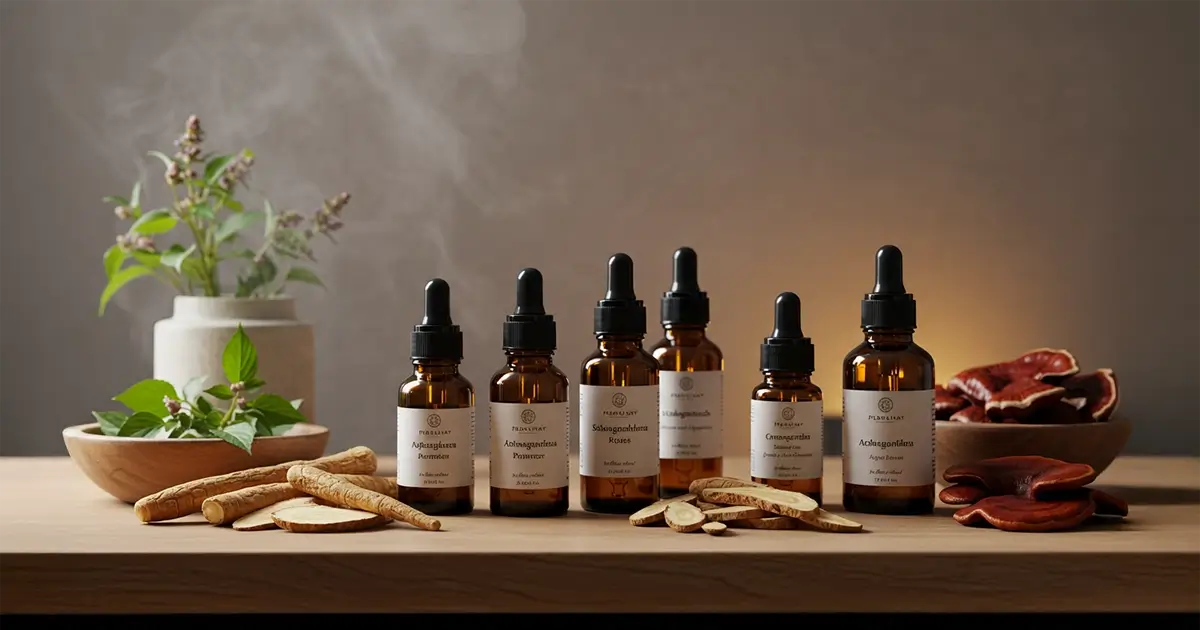Ready to turn your bathroom shelf into a mini apothecary? Today I'm chatting about adaptogens in skincare - botanicals that thrive under stress and lend their chill vibes to your complexion. We'll unpack what they are, why formulators can't stop talking about them, and how Ashwagandha, Ginseng, and other rooty heroes help skin stay balanced.
From Herbal Tonic to Face Cream: How Adaptogens Earned a Spot on the Vanity
Ask any herbalist to define an adaptogen and you'll hear a simple theme: plants that help the body manage biological stress. Coined in the 1940s by Russian scientist Nikolai Lazarev, the term first belonged to roots like Siberian ginseng that kept soldiers sharp in brutal winters. Fast forward to today, the same assets that steady cortisol inside the body are being applied on top, literally, to calm irritated skin.
The outermost layer of skin, the stratum corneum, acts like a brick wall holding water in and irritants out. When pollution, UV, or sleep deprivation chip away at those bricks, redness and flakiness follow. Adaptogenic extracts answer with antioxidant molecules, amino acids, and polysaccharides that nudge the barrier back into homeostasis. Think of them as tiny repair workers clocking in after a night shift.
Most adaptogens hail from ancient medical systems - Ayurveda, Traditional Chinese Medicine, and indigenous Siberian pharmacopeia. Using them in serums isn't cultural appropriation if brands source ethically and honor the communities that protected this knowledge. It also means we have centuries of empirical evidence before the double-blind trials caught up.
What makes adaptogens unique is their bidirectional action: they nudge physiology toward equilibrium instead of pushing it in one direction. On stressed skin, that may mean reducing cortisol-induced collagen loss, yet on sluggish skin it can gently wake circulation so nutrients arrive faster. This Goldilocks effect keeps overtreatment syndrome, tight shiny sensitised cheeks, off the table.
Chemically, many adaptogens share triterpenoid saponins, polyphenols, and trace minerals that work in concert. They mop up free radicals, but they also modulate gene expression linked to inflammation and matrix degradation. Translation: less redness today, fewer fine lines tomorrow, and a barrier that does not throw tantrums at every weather change.
Dermatologists who once dismissed botanical extracts as quaint are now presenting posters at conferences on adaptogenic serums. The reason is straightforward: patients crave multitaskers that feel gentle. When a single plant addresses oxidative stress, lipid loss, and post-inflammatory hyperpigmentation, the routine shrinks, and compliance skyrockets.
Meet the MVPs: Three Adaptogens Making Waves
Ashwagandha: The Overnight Stress Whisperer
Withania somnifera, nicknamed Indian ginseng, contains withanolides that scavenge free radicals, dial down inflammatory cytokines, and improve microcirculation. A 2023 randomized study found an 8% lotion lifted hydration by 20% and elasticity by 16% in just 60 days In this clinical trial. I've tried a milky essence with 1% standardized extract on nights I answer emails until 1 a.m., and my cheeks wake up less blotchy. Pro tip: look for the INCI name early in the ingredient list so you know you're getting a meaningful dose.
Panax Ginseng: Circulation Cheerleader
Panax literally means "cure-all" in Greek, and while that's optimistic, the root does pack ginsenosides - saponins that increase dermal blood flow, which brings nutrients to sluggish skin. Researchers note that topical red ginseng reduced UVB-induced barrier damage in mice and may encourage collagen synthesis, explaining why K-beauty sleeps in it. If caffeine makes your face look flushed, ginseng offers pep without the panic.
Holy Basil (Tulsi): Pollution Shield
Urban dwellers, this leaf is for you. Tulsi defends against heavy-metal oxidative stress, neutralizing reactive oxygen species before they wrench pigment from melanocytes. I keep a mist with tulsi hydrosol on my desk - one spritz halfway through a Zoom marathon and blue-light dryness feels less dramatic. Because the aroma is herbal and peppery, it doubles as a 4 p.m. pick-me-up without wrecking your coffee budget.
Reishi Mushroom: The Fungal Moisture Magnet
Lingzhi (Ganoderma lucidum) earns its place with beta-glucans that imitate skin's own saccharide structures, pulling water into the stratum corneum. The polysaccharides also calm histamine pathways, so if you battle seasonal flare-ups, reishi can act like a soothing whisper. Texture-wise, reishi extracts lend a silky slip, making it a sensorial treat in emulsion sunscreens.
Rhodiola Rosea: Mountain-Forged Antioxidant
Grown on Arctic cliffs, rhodiola stores rosavins and salidroside that guard plants from intense UV and winds. Topically, those molecules donate electrons to photo-excited radicals before they gnaw at collagen. I reach for a rhodiola ampoule after beach holidays to prevent that weathered-leather look that sneaks in come September.
Building a Routine Around Adaptogens
Morning cleanse, vitamin C, adaptogen serum, moisturizer, and sunscreen: that is my simple stack when deadlines tighten. The serum's calming actives offset the mildly acidic vitamin C, lowering the risk of lunchtime flake-fest. If you prefer niacinamide to C, pair it with ginseng for a barrier-boosting combo that feels like brunch for your epidermis.
Night is when I load heavier hitters. Two or three evenings per week I alternate a retinal-aldehyde cream with a balm rich in ashwagandha and oat peptides. Retinoids remodel, adaptogens soothe - the duo keeps me glowing and comfortable. Curious about peptides? I covered them here for fellow collagen nerds.
Finally, masks: a clay smoothie mixed with powdered licorice and tulsi once a week draws out grime without drying me into a raisin. Leave it on no longer than ten minutes; adaptogens are helpers, not magicians. Rinse gently, tap on a watery toner, then lock moisture in with something occlusive but breathable.
If you already have a sprawling routine, slide adaptogens into a hydrating mist. A quick mist after cleansing preps skin, balances pH, and leaves a dewy canvas for actives. It is also the laziest way to add botanical diversity without playing ingredient Tetris.
Folks with oily zones can pick gel textures with fermented adaptogen filtrates. Fermentation breaks big molecules into smaller, bioavailable bits and reduces stickiness. Think kombucha for your cheeks - minus the vinegar smell.
Do not ignore the neck and décolletage. The skin there has fewer sebaceous glands, meaning less natural lubrication. Work leftover serum downwards with soft upward strokes, treating that area like an extension of your face.
Reading Labels Without a Chemistry Degree
Marketing can be murky. If a product boasts "herbal complex" yet plants appear after phenoxyethanol (which is typically 1% or lower), you're paying for perfume, not potency. Genuine adaptogenic skincare lists the botanical name plus extract ratio, such as Withania somnifera root extract (1 : 10). Some brands use liposomal delivery so actives reach deeper layers, a fancy term meaning they wrapped the extract in fat bubbles. Worth it when budget allows.
Look for certification logos like Ecocert COSMOS Organic or USDA Organic - these signal traceable sourcing free from synthetic solvents. Vegan certification is handy, too, because many adaptogen newcomers avoid potential contamination with animal by-products. That said, an uncertified serum can still shine; certificates are pricey, especially for small cooperatives. Email the brand's customer service if information feels vague. A transparent company will happily share their certificate of analysis.
Watch out for essential-oil overload. Some brands cram adaptogens into fragrant oils that smell divine but can provoke dermatitis. If you detect a perfume blast stronger than your morning latte, scan the list for citrus peel or peppermint oils and patch test first.
Safety Check: Who Should Pause Before Plunging In?
Although adaptogens are generally well tolerated, a natural label is not a free pass for everyone. Individuals with known ragweed or nightshade allergies should tread carefully around ashwagandha, since botanical families sometimes cross-react. Perform a patch test behind the ear for three consecutive evenings; itching or heat warrants a rethink.
Because many adaptogens possess phytoestrogenic compounds, those undergoing hormone-sensitive cancer treatment must consult their oncologist before use. The risk from topical exposure appears low, yet vigilance always wins over regret.
Finally, shelf life matters. Adaptogen extracts oxidize faster than synthetic peers. If your serum changes color or develops a funky odor before the use-by date, toss it. Skin infections cost more than a new bottle.
Inside the Lab: Extracting and Stabilizing the Good Stuff
Harvesting roots is only half the battle. Chemists choose between water, glycerin, or super-critical CO₂ extraction depending on the target molecules. Water captures polysaccharides for hydration, while CO₂ teases out oil-soluble antioxidants that slip through sebum. Brands sometimes combine both to cover all bases.
Once extracted, actives must remain potent until your last pump. Enter chelators, air-less pumps, and micro-encapsulation. Micro-capsules act like transparent M&M shells, cracking open when you spread the lotion so fresh molecules hit the stratum corneum on contact. It's nerdy but genuinely helpful for unstable performers like rhodiola's salidroside.
Preservatives get a bad rap online, yet they're the guardians preventing bacterial parties in your moisturizer. Modern green chemists lean on potassium sorbate, ethylhexylglycerin, and fermented radish root filtrate - gentler options that still pass EU challenge tests.
DIY Brews: Fun Experiment or Microbial Mayhem?
I see endless TikToks blending powdered ashwagandha into aloe gel. It looks wholesome, but powders clump and create hotspots where bacteria can multiply. Unless you're willing to sanitize equipment and measure pH and preservative levels meticulously, leave the heavy lifting to labs.
If the alchemist within must play, infuse dried holy basil in jojoba oil for two weeks, strain through cheesecloth, and use as a body oil. The wider surface area of limbs means minor inconsistencies won't set off facial breakouts. Just store the bottle in the fridge and finish within three months.
Remember, plant parts vary seasonally. The ashwagandha powder you grabbed on sale last winter may have half the withanolide content of a fresh autumn harvest. Commercial suppliers standardize batches to active markers, an assurance your homemade jar lacks.
FAQ
Can adaptogens replace retinoids?
No. Retinoids speed up cell turnover, while adaptogens focus on reducing stress-induced damage. They complement each other when alternated, not substituted.
Will topical ginseng make me jittery like the supplement does?
Topical application stays in the epidermis, so it won't raise heart rate. It might energize your complexion, though.
How long before I notice results?
Expect small wins - softer texture, toned-down redness - within four weeks. Deeper changes such as wrinkle depth need eight to twelve.
Are adaptogens safe during pregnancy?
Data are limited. Until more studies emerge, discuss any formula with your healthcare provider and consider fragrance-free basics instead.
Do I need to refrigerate adaptogen serums?
Not necessarily. A dark cabinet away from steamy showers is enough. Cold storage can prolong freshness but isn't mandatory.
What texture works best for winter months?
Look for balmy creams with shea or cupuaçu butter carrying adaptogens. They seal moisture while herbal actives mend the barrier overnight.
Conclusion
Adaptogens bring the wisdom of ancient pharmacopeias to modern vanity tables, offering antioxidant back-up, barrier support, and a moment of ritual in hectic routines.
Here's the fun part: experimenting within your budget and tolerance to see which root or leaf makes your face happiest. Thank you for geeking out with me on plant science today. See you in the next post - until then, take good care of your skin!


Comments (0)
No comments yet - be the first to share your thoughts!
Leave a Reply
Your email address will not be published. Required fields are marked *